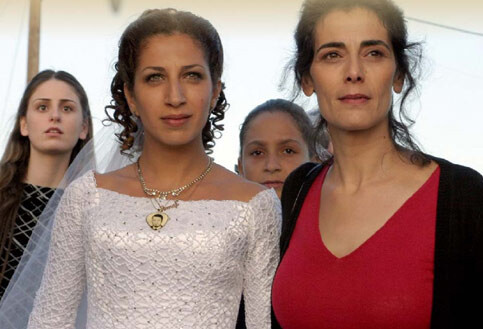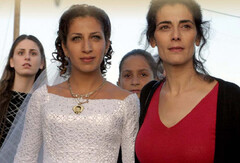The Electronic Intifada 21 July 2005

Mona (Clara Khoury), Amal (Hiyam Abbas), and Amal’s daughters
Maybe I should learn to be less sensitive but when director Eran Riklis
arrived in Nazareth last month for the screening of his much-garlanded film
“The Syrian Bride”, he got off on the wrong footing the moment he walked
through the door.
A handful of Nazerenes had been invited to a film studies workshop, keen to
see an Israeli movie that has won universal praise, as well as more than a
dozen awards, for its uplifting and supposedly non-partisan message: that
we must never let go of our humanity or our dignity, even in the face of
the brutalitising effects of the Middle East conflict.
“The Syrian Bride” boasts another innovation: it is a genuinely cooperative
production between Israelis and Palestinians. Riklis, its Israeli director,
co-wrote the screenplay with a Palestinian woman, Suha Arraf, set it in the
Druze village of Majd al-Shams in the occupied Golan, and used a largely
Palestinian cast speaking mainly in Arabic.
But as Riklis walked into the Nazareth hall where his film was to be
screened, trailing some 30 American and Israeli film students in his wake,
he did not appear quite the emissary of coexistence and understanding the
locals were expecting.
Accompanying him and his group was a “security guard” - a young Israeli man
with a rifle slung casually over his shoulder. It was hard to see why
Riklis thought he needed a paid armed escort to enter the Israeli city of
Nazareth, or what kind of impression he thought he was making on the city’s
film enthusiasts at the screening.
(In the last few years it has become common to see coach parties of Israeli
teenagers wandering around Nazareth, the capital of Israel’s one million
Palestinian citizens, on a school outing with their teachers, a “security
guard” in tow. Not a few local shopkeepers can be heard muttering under
their breath that, if Israeli schools really think Nazareth is so dangerous
that armed protection is called for, why not simply keep their precious
charges away from the place?)
Unfortunately, however, Riklis’s choice of company was far from my only
concern.
The Israeli director has chosen an unusual subject for his film: the tiny
Druze community of the Golan Heights, a moutainous wedge of territory
belonging to Syria until 1967, when it was occupied by Israel during the
Six-Day War and then illegally annexed, along with what remained of its
Syrian population.
Today the Golan’s Druze can speak to relatives on the other side of the
border, in Syria, only by approaching the northern limits of Majd al-Shams
and shouting through loudhailers across a strip of no-man’s land under the
control of international peacekeepers.
The one small concession made by Israel and Syria is an agreement to allow
the passage of brides across the border, from Israel to Syria and the other
way. Once the crossing has been made, however, there is no going back: the
bride is not allowed to see again the family she has left behind.
As I and several Palestinian friends sat through the film, our initial
surge of pleasure in seeing a humanising portrait of Arab life inside
Israel - even if Syrian Druze rather than Palestinian - gave way to a
sinking feeling, followed by a mounting queasiness at the movie’s soft but
nevertheless insidious racism.
The dark cloud of despondency was punctured only briefly near the film’s
end by an uncontrollable guffaw of disbelief from the Palestinians in the
audience as the one villainous Jew in the film, the manipulative Israeli
police commander, is given his comeuppance by the Druze family.
As they struggle at the border with the paperwork needed to get Mona, the
bride, over to Syria, the police captain arrests her father, Hammed, a
veteran pro-Syrian political activist who has recently been released from
jail. Hammed has broken the law by entering a closed military zone.
The police commander, however, is forced to leave empty-handed after one of
Hammed’s sons challenges him to produce an arrest warrant.
Riklis was apparently concerned only that the movie appear credible to
Israeli Jews and an international audience. He must have known that no
Palestinian would ever swallow the idea that the decision of an Israeli
security official could be successfully opposed in a closed military zone.
Or maybe Riklis himself does not know that his government has been
operating a state of emergency for nearly six decades, with draconian
powers inherited from the colonial era of the British Mandate. Not only can
Israeli officials arrest anyone they please in a closed military zone - and
declare pretty much anywhere they please such a zone - but they can jail
them too using an administrative order. Such an order does not require that
charges be laid and the detention cannot be contested in court.
But back to the film. “The Syrian Bride” has many virtues, including the
fact that it gives a flavour of Israeli society’s complexity and diversity,
and offers us an inspiring character, a strong and principled Arab woman,
in the shape of Amal, played by the excellent Hiam Abbass. Riklis also
wrings genuine pathos from the desperate situation of the bride facing
Israeli and Syrian bureaucratic intransigence.
But these successes, and the sympathy he wins from the audience, make
Riklis’s major misjudgments all the more disturbing, as was suggested by
the feverish round of applause he received from the Los Angeles and Tel
Aviv film students at the end of the screening.
During the talk afterwards, Riklis said he had cut one early scene set in
Damascus from the film because whichever way he presented it the Arab
characters looked like racist Arab stereotypes from Israeli TV of the 1970s
and 1980s.
Maybe he should have cut a few more scenes. The Syrian characters are
either lazy jobs-worth, mustachioed officials or overweight comic figures,
including Mona’s cousin, the man she is due to marry in Syria. The contrast
with the sympathetic and complex Druze characters in the Golan suggests,
even if only subliminally, that nearly four decades of Israeli occupation
have helped “civilise” the Druze there, separating them not only physically
but also culturally, intellectually and socially from their relatives.
The Israelis, by contrast to the Syrians, are far more sympathetic,
apparently trapped by circumstances into making arbitrary and sometimes
unfair decisions but never maliciously. Our “pair of eyes” in the film is
the bumbling Jewish cameraman there to record the wedding, who brings with
him ignorance of the Druze way of life but also a warm human curiousity
and, later as he starts to befriend Mona, a great sensitivity towards the
family’s predicament.
While one empathetic Jew in the film might have been considered reasonable
balance, we end up with a string of compassionate soldiers, one of whom
warmly congratulates the family as they turn up at the border and another
who gives up his seat at the crossing point when it is clear Mona will have
to wait.
Even the balding bureaucrat who arrives from Jerusalem to approve the
documents needed for Mona to cross into Syria eventually bends over
backwards to help. He agrees to erase an offending Israeli exit stamp with
correction fluid, thereby single-handedly altering official policy, even
though he cannot reach any of his bosses for authorisation.
Whereas the Israeli Jews in the film are always compassionate and creative
in the face of official obstructions, the Syrians are clearly not. Israeli
failings are never intentional or malign, only signs of incompetence or
caution.
Similarly, although the figure of Amal is an inspirational one, her
ambitions for self-betterment are framed entirely in terms of the
opportunities offered to her from her belonging to Israeli society. She has
the chance for self-improvement, the film suggests, only because of the
offer of a place studying at Haifa University, in Israel proper.
Conversely, the limitations placed on Amal are entirely derived from her
membership of the Druze community, and the deadening hand of tradition. The
obstacles thrown in her way come from her husband, who fears her behaviour
will lose the family respect in the eyes of the rest of the community.
The film seems to forget that Amal, who demonstrates courage and
independence from the opening scene in the film, did not learn these
qualities in Israel but from from her life in Majd al-Shams, as a Druze
woman living under a repressive military occupation.
Riklis’s treatment of the character of Amal encapsulates in microcosm the
faults of this film. Rather than concentrating as he does on the internal
failings of Druze and Arab society, he could have given equal, if not more,
weight to the damage inflicted on the Druze community by Israel’s
occupation, and the ways in which that factor in itself shapes and
reinforces the limitations imposed on Druze women.
As one of the characters observes in a different context, but which could
equally have been spoken by Amal to her husband: “You do to me what the
Israelis did to you.”
Riklis is an Israeli director. His responsibility as an artist and as an
honest human being is to criticise his own, Israeli Jewish society before
he starts blaming the victims of long-standing Israeli policy. He should
put his own people’s considerable responsibility for the tragedy of the
Middle East under the spotlight at least as much as the well-known
weaknesses of Arab society.
Riklis referred to himself during the talk afterwards, to murmurs of
approval from his American and Israeli audience, as “a man of peace”. But
peace in the Middle East requires a great deal more soul-searching than
Israeli artists like Riklis currently seem capable of.
The fact that he has won international acclaim for his film suggests
another depressing thought: just how far those living outside the region
are from understanding what is required of them to help bring peace to the
region.
Jonathan Cook is a journalist whose work has appeared in the Guardian, International Herald Tribune, Al-Ahram Weekly, and other newspapers. Based in Nazareth, Cook is an occasional contributor to EI. He is currently writing a book on the Palestinian citizens of Israel.
Related links:




